Springfield Armory has recently released its SA-35 9mm, a new iteration of the famous Browning Hi-Power, and shooters are understandably interested in the new pistol. What’s curious about this interest is that for many years, sales of the Hi-Power languished, tooling wore out and costs increased to the point where Browning (FN) dropped the pistol from its line a few years ago. Into that vacuum came various clones of the pistol, primarily Turkish-made, and they seemed to be solidly built and have served well.
Reportedly, there are first-class gunsmithing shops, such as Cylinder & Slide (Cylinder-Slide.com/category/cp108) and Tiger McKee, that use the Tisas Hi-Power clone import ($564 at BestGuns.net) for the basis of their creations. Modifications can range from a replacement extractor spring, a hammer that won’t bite you, new sights, or a wonderful trigger job all the way to complete custom pistols. Costs can run the gamut from two-digit pricing to a full four figures. Quality aftermarket parts for such modifications are also available at Cylinder & Slide and Brownells (Brownells.com).
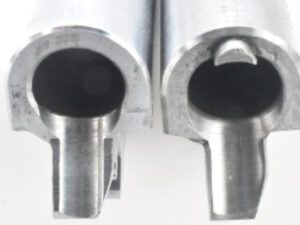
When we looked at the list of features on the new SA-35, we saw that Springfield agreed with our ideas regarding how a modern Hi-Power should be fitted out. About 20 years ago, at a not inconsiderable expenditure of time and funds, we bought a Browning Hi-Power then changed the sights, trigger, grips, various internal parts, surface textures, and more. Total investment in 2003 dollars for that pistol and modifications was more than $1k. Contrast that with the new SA-35 at an MSRP of $699.
To see whether Gun Tests readers would be wiser to buy a new Hi-Power clone or try to get one of the real things, we obtained a brand-new Springfield Armory SA-35 for review. We already had on hand an almost-mint condition Browning Hi-Power from circa 1999 that had not been modified. It would supply a picture of where the current-day gun owner would start if he or she were to get the bug for a Hi-Power that could be improved as a shooter, not as a collectible.
The Starting Point
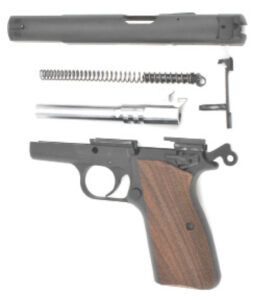
Our historical comparison piece is a Browning-marked Hi-Power made in Belgium and assembled in Portugal. Fit and finish are almost perfect. Estimated replacement value near the end of 2021 was more than $1200 on auction sites like GunBroker.com. As of this writing, several months after the introduction of the Springfield SA-35, Gunbroker.com has several Browning Hi-Powers listed (and getting bids) in the $800+ range. We like Hi-Powers and had been watching the auction sites to find a good sample in acceptable condition at an affordable price. In 2018, after Browning announced they were ceasing production of the Hi-Power, prices jumped substantially. Basic economics here — the tighter the supply, the higher the price. Just look at gasoline these days. There was no new supply, so prices went up. With the new SA-35, Springfield Armory appears to have engineered a product that satisfied the Hi-Power customer base to the point where they accept the new Hi-Power as a substitute for the old — at least as far as looks and function go. Of course, there will always be those who want the panache of having an original. Still, the effect has been to provide new supply, which then satisfies some of the existing demand. That reduces some of the concern over not being able to find a serviceable Hi-Power to shoot and coaxes the overall price to drop.
Our concern, of course, is to see how the new SA-35 fared as an everyday shooter, and to recommend the new pistol if it satisfied the gimlet-eyed gaze of experienced concealed carriers. If it were as good as an original Hi-Power for less money, then we could confidently recommend it to the Gun Tests readership as a self-defense pistol, effectively saying, “Yes, go ahead and spend $700 and change on this 9mm handgun.” If the SA-35 weren’t a gun we would use to save our lives or the lives of our family, then we would say, “Nah. Pass.”
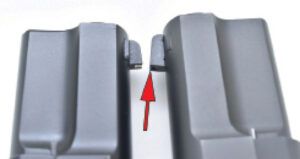
To see how Springfield’s new gun performed at the range, we shot it side by side with the vintage Hi-Power using four different types of ammunition, mixing it up between FMJ and defensive loadings. First was 115-grain Remington Range ammo, along with Winchester White Box 115-grain FMJs. Our defense offerings were the Black Hills 125-grain Subsonic HoneyBadger and Hornady’s 115-grain FTX rounds.
All shooting was done at American Shooting Centers in Houston. Accuracy was tested at 15 yards by shooting multiple five-shot groups from a well-sandbagged Caldwell Pistolero shooting rest assisted by a Mini DRC Fortune Cookie from Wiebad.com. Velocities were obtained via LabRadar. Here’s what we learned.
The Basics
The SA-35 is still a short recoil operated, tilting-barrel, semi-auto pistol chambered in 9mm. Minimizing aluminum parts, the use of forged steel brings the weight of the SA-35 to up around 2 pounds and brings a solid heft to the pistol. Length is 7.8 inches overall, height is around 5.0 inches, and the cold-hammer forged barrel is 4.7 inches long. Trigger span is 2.6 inches, front strap is 2.5 inches, and back strap height is 3.5 inches. The original Browning’s measurements were effectively the same. So where did they differ, and by how much in the critical areas?
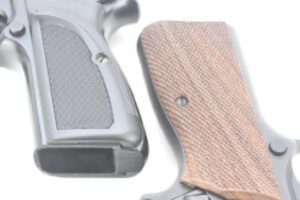
The SA-35 comes with a 15-round magazine, where the original employs a 13-rounder, though either mag works in either pistol. Using the provided mags, and adding an extra two rounds for the Browning, the HP manages to weigh out at an insignificant 0.026 pounds more than the SA. The Browning is also slightly wider overall (1.48 inches HP versus 1.32 inches SA), primarily because of the thumb rests on the grip panels. We measured the SA’s overall height at a whopping 0.01 inches taller than the HP, which has a shorter rear sight. The SA also had a longer sight radius at 6.4 inches versus 6.25 inches for the HP – again, different sights.
The small beavertails are almost identical, but the safeties are not. This HP is equipped with an ambidextrous version with rounded edges. The SA has a left-side-only safety with a much more usable flat and extended design. The biggest change we found on the exteriors of the pistols was that the SA had 21 grasping grooves and the HP had 23. There was no functional difference in this for our shooters.
Grips
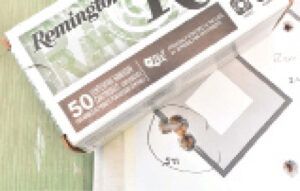
The grip shape on the vintage Hi-Power is great, but we never really found anyone those black polymer grip panels fit. We felt they were too wide, with that somewhat obnoxious thumb shelf, and had a texture too smooth to allow any real grasp by the hand. Add in smooth front and back straps, and we thought this legacy design was too slick for speed work.
Springfield changed those grips out to checkered walnut, bringing a lot more traction as well as a more aesthetically pleasing look. In our rebuild of a Hi-Power years ago, we added skateboard tape to the front strap, which also happened to cover the serial number. Because this wasn’t a permanent alteration of any kind, we didn’t know of any legal problems this created, but Springfield solved the problem by simply marking the serial number on the left side of the frame. The front and rear straps are still slick, but we see nothing to prevent modifications designed to enhance grip adhesion.
Magazine Wells and Magazines
Springfield beveled the SA’s mag well just a little — something that helps mag changes more than it sounds like it would. Then somehow through the process, they managed to squeeze two more rounds into the magazine for a total of 15. We think Springfield accomplished that primarily by redesigning the follower in the mag. The older version has support legs extending down from the follower, creating an overall length for the follower of about 1.3 inches. When we checked the new version, those legs had been removed, thereby shortening the follower to just over a half inch. That leaves room for more cartridges.
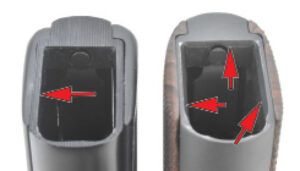
Mec-Gar is the original equipment manufacturer for these magazines, and the company tends to produce a very good product. You might be surprised at how many manufacturers use Mec-Gar mags as original equipment. So, additional magazines are available (when in stock) at supply houses like MidwayUSA.com and Brownells.com. At Midway, 13-round Mec-Gar magazines run $23 and 15-rounders are $26. If you want original Browning 13-round mags, the price goes up to $60 each. Early models are easy to spot — witness holes on the original 13-rounders are on the back of the mag. New Mec-Gar mags and most others we’ve seen have the witness holes on the right side. New Mec-Gar 15-round magazines marked “Springfield Armory” are available from Springfield for $39 each.
Sights
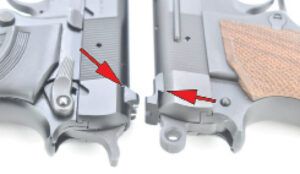
The sights on the original Hi-Powers were vestigial at best, reminding us of early attempts on the 1903 pocket hammerless or the early 1911s. They were usable but designed for much younger eyes. The later makes of the Browning Hi-Power addressed some of those issues. Those later sights got taller, wider, and more squared — or, in the aggregate, simply became more visible. Both sets were mounted in dovetails, which allowed for drift adjustment. The HPs used a somewhat curious pattern of vertical white rectangles painted into the sight blades. Those squares were visible, but looking almost identical, we felt the three squares could be too easily confused when shooting fast. We simply painted out the two rear rectangles on the vintage HP.
Springfield took the sight improvements a couple of generations past our efforts. The front sight still employs a single white dot. Though not our favorite (we’ve become spoiled by fiber-optic inserts), we were able to track this taller front sight well in various exercises. The rear sight is dang near perfect. As is the current rage, the rear sight body is a lowered shelf that raises up into a great rear blade. Not-too-high, not-too-short, the serrated rear sight provides a U-shaped notch that draws the eye to the front sight. This body design also allows for single-handed tactical-racking, or whatever you wish to call it.
Hammers and Safeties
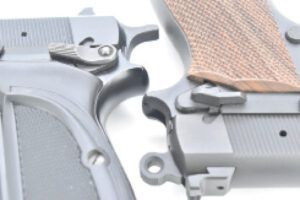
Several of the working parts on the SA also saw improvement. First and foremost (to folks with largish hands) could be the hammer. The HP uses a spur-type hammer, which seldom failed to bite our hands while shooting, often to the point of drawing blood during extended sessions. The SA uses a rowel-style hammer which, though we felt it contact our hand a bit during shooting, caused no damage. That simple change makes the SA much more comfortable to shoot.
The thumb safety on our Browning HP is a rounded, ambidextrous affair. While accessible to both thumbs, we feel it is too narrow and shaped incorrectly for being operated by either hand. The Springfield stayed left side only with the safety but completely redesigned the piece. The SA’s safety provides a wide, flat ledge with which the thumb can move the on/off switch.
Triggers
Also important are changes to the trigger. As we understand legend on the design of the 1911, the U.S. Army mandated that pistol’s grip safety as an extra security measure for cavalry troopers needing to reload their pistols while on horseback. We have solemnly sworn to not reload our 1911s while sitting a horse, but we have yet to see that safety eliminated. The magazine safety on earlier Hi-Powers is supposed to be another anachronistic act of design surrender to French cavalry officers. If the magazine were not present and inserted correctly in the mag well, the pistol could not be fired. Theoretically, that means that someone whose firearm was about to be taken away from them could press the mag release and disable the trigger possibly preventing their pistol from being used against them. It also meant that they could not use that last chambered round, when necessary, if they were mid-reload. Most manufacturers have since decided to eliminate this feature.
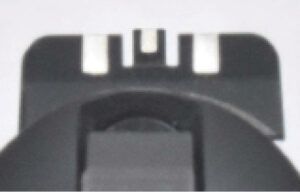
To its credit, Springfield did not include the magazine safety on the SA-35. We noticed Springfield also decided not to include the firing-pin safety found on our earlier HP. Many are familiar with the term “tolerance stacking,” where parts designed with just a little slop in them are then fitted to more parts, also with just a bit of extra play built into them to make sure that everything works. The same principle can work on triggers in firearms. The more contact points and linkages there are between trigger and sear, the more friction is created in the movement of those parts. That detracts from a good trigger pull. This can be obviated to a large part by proper fit of and polishing of the parts. It appears that Springfield addressed this with the SA-35. We mentioned two contact points that were eliminated, and we can feel the smoother pull. While it will never be confused with a tuned 1911 trigger, the SA’s trigger is crisp, predictable, and manageable. Topping it off, it feels to us that the mainspring is lighter than on our Browning HP. That also contributes to the overall quality of the trigger press and made the slide easier to rack. Slide-retraction effort on the SA was a noticeable 18% less than on the Browning.
Feed Ramps and Feeding
Members of our team have used Speer Gold Dot for several decades. Hornady Critical Defense has also done a good job for us. Both of those loads tend to feed very consistently in virtually every platform we have tested them on. Pistol feed ramps can be a bit more finicky using designs such as the bullet from Lehigh Defense (now owned by Wilson Combat). The flutes on the bullet nose can easily catch on the feed ramp and did so a couple of time with the Browning. The SA did a better job of feeding them than the HP. Exactly why, we can’t tell you.
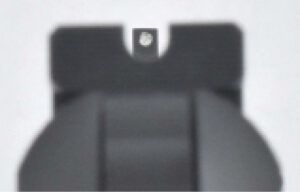
But we can make some educated guesses. Springfield claims that they re-engineered the feed ramp on the SA, and we can see differences. The dished-out channel on the ramp is a bit narrower on the SA, even though the ramps proper are the same widths. Our eyeball calipers tell us the ramp angles are very close, if not exactly, the same. It appears the throat on the SA is a bit deeper than the HP, with a slightly better chamfer on the inside edges of the chamber. There are also fewer tool marks to be seen on the SA’s ramp. The result was the SA fed somewhat better than its predecessor.
The only real feeding issue we noted was the thumb-forward grip we’ve used for the last 20 years. That can allow the forward thumb to touch and elevate the slide stop under recoil, causing the SA’s slide to lock to the rear. We shifted our thumbs, and the problem went away.
Range Results
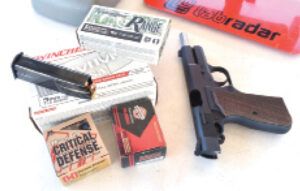
Accuracy was good for both pistols and was amazingly similar for the first two ammo types tested. The SA shot an average of 1.39 inches with the Remington 115-grain range ammo, and the HP shot a 1.38-inch average for the same ammo. Best group with the SA with that ammo was 0.57 inch. The Browning was able to turn in a 1.15-inch group for its best effort. Next, the Springfield shot a 1.9-inch average with the Winchester white box, with a best group of 1.66 inch. The Browning shot 1.84 and 1.70 inches respectively. We thought that the delta in the average groups for the first two ammo selections was statistically insignificant.
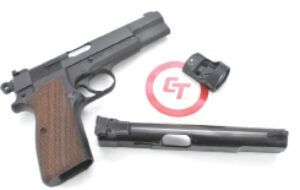
Things changed a bit when we got into the defensive ammunition. Differences in velocity increased to about 30 fps, with the Springfield winning both times. The Springfield fired the best average group as well as the smallest group with both the Black Hills 125-grain subsonic load as well as the Hornady 115-grain Critical Defense. All in all, the Springfield shot better groups in three out of four opportunities and had the tightest group for all four loads.
The speed drills sealed our decision about which pistol we preferred. The SA posted the best times for the first shot, split times between shots, and total times for every run we made with two different drills. We chalk this up to the SA’s sights being easier to pick up, the SA providing a more secure grip, and the SA trigger being a bit better.
Our Team Said
Were we to own samples of both pistols (and we do), we would not hesitate to use either gun as a shooter. If collectability is not the most important factor, we would choose the Springfield Armory SA-35 over buying a Browning Hi-Power because the SA-35 is better in every area that should matter to the modern self-defense shooter. If we were choosing one as a base gun from which to build a more customized pistol, both would suffice. But the nod goes to Springfield’s SA-35 as a base gun to upgrade. There is less work to be done on it.
Springfield Armory SA-35 9mm Luger, $699
Gun Tests Grade: A. If you’re not looking for a collectible, then choose the Springfield Armory SA-35 over a stock Browning Hi-Power. The SA-35 is less expensive, has a better trigger, better sights, and is completely modern.| Action Type | Semi-auto single action |
| Overall Length | 7.8 in. |
| Overall Height | 4.8 in. |
| Maximum Width | 1.32 in. |
| Weight Unloaded | 1.84 lbs. |
| Weight Loaded | 2.41 lbs. |
| Slide | Blued forged carbon steel |
| Slide Retraction Effort | 17.2 lbs. |
| Receiver Material | Forged steel |
| Finish | Matte blue |
| Front Strap Height | 2.4 in. |
| Back Strap Height | 3.4 in. |
| Barrel Length | 4.7 in., 1:10 twist |
| Grip Thickness (Maximum) | 1.32 in. |
| Grip Circumference | 5.4 in. |
| Magazines | (1) Mec-Gar 15 round |
| Front Sight | White dot, drift adjustable in dovetail |
| Rear Sight | Black serrated tactical rack rear, drift adjustable in dovetail |
| Sight Radius | 6.4 in. |
| Trigger Pull Weight | 4.8 lbs. |
| Trigger Span | 2.6 in. |
| Safety | Manual thumb safety |
| Warranty | Limited warranty for original purchaser |
| Telephone | (800) 680-6866 |
| Website | Springfield-Armory.com |
| Made In | U.S.A., Illinois |
Browning P35 Hi-Power 9mm Luger, ~$1000
Gun Tests Grade: B+. We own samples of both pistols, so we would be comfortable using either one for home or self defense. Of course, if you want a great historical firearm to collect and shoot, then the Hi-Power is your only choice. Also, we wouldn’t mind upgrading a Hi-Power from its base condition to something more useful, but that would be much easier to do with an SA-35.| Action Type | Semi-auto single action |
| Overall Length | 7.8 in. |
| Overall Height | 4.9 in. |
| Maximum Width | 1.48 in. |
| Weight Unloaded | 1.83 lbs. |
| Weight Loaded | 2.38 lbs. |
| Slide | Matte blued carbon steel |
| Slide Retraction Effort | 21.3 lbs. |
| Receiver Material | Matte blued carbon steel |
| Front Strap Height | 2.5 in. |
| Back Strap Height | 3.5 in. |
| Barrel Length | 4.7 in. |
| Grip Thickness (Maximum) | 1.48 in. |
| Grip Circumference | 5.5 in. |
| Magazine | (1) Mec-Gar 13 round |
| Rear Sight | Drift adjustable in dovetail |
| Front Sight | Drift adjustable in dovetail |
| Sight Radius | 6.25 in. |
| Trigger Pull Weight | 5.4 lbs. |
| Trigger Span | 2.6 in. |
| Safety | Ambidextrous manual thumb safety |
| Warranty | None |
| Telephone | (800) 333-3288 |
| Made In | Belgium, assembled in Portugal |
9mm Luger Range Data
We tested at American Shooting Centers in Houston. We used a LabRadar chronograph ($559) to determine muzzle velocities. We fired all shots for group from a well-sandbagged Caldwell Pistol Rest from MidwayUSA and a mini-DRC Fortune Cookie bag from Wiebad.com. Accuracy averages are from five-shot groups fired at 15 yards.
| Remington Range 115-grain FMJ T9MM3 | Browning P35 | Springfield SA-35 |
|---|---|---|
| Average Velocity | 1173 fps | 1197 fps |
| Muzzle Energy | 352 ft-lbs. | 366 ft-lbs. |
| Average Group | 1.38 in. | 1.39 in. |
| Best Group | 1.15 in. | 0.57 in. |
| Winchester White Box 115-grain FMJ USA9W | Browning P35 | Springfield SA-35 |
| Average Velocity | 1203 fps | 1220 fps |
| Muzzle Energy | 370 ft-lbs. | 380 ft-lbs. |
| Average Group | 1.84 in. | 1.90 in. |
| Best Group | 1.70 in. | 1.66 in. |
| Black Hills Subsonic 125-grain HoneyBadger | Browning P35 | Springfield SA-35 |
| Average Velocity | 1008 fps | 1043 fps |
| Muzzle Energy | 282 ft-lbs. | 302 ft-lbs. |
| Average Group | 2.33 in. | 1.85 in. |
| Best Group | 1.99 in. | 1.64 in. |
| Hornady Critical Defense 115-grain FTX JHP 90250 | Browning P35 | Springfield SA-35 |
| Average Velocity | 1152 fps | 1185 fps |
| Muzzle Energy | 339 ft-lbs. | 359 ft-lbs. |
| Average Group | 2.15 in. | 1.54 in. |
| Best Group | 1.58 in. | 0.92 in. |
Drill Data (5x5x5)
Process: Fire five shots from low ready at a 5-inch circle placed at 5 yards. Numbers are averages for two repetitions.| Pistol | Time to First Shot (seconds) | Split Average (seconds) | Total Time (seconds) |
|---|---|---|---|
| Browning Hi-Power | 1.02 | 0.26 | 2.06 |
| Springfield SA-35 | 0.95 | 0.236 | 1.9 |
Drill Data (5x7)
Process: Fire five shots from low ready at a 8-inch circle placed at 7 yards. Numbers are averages for three repetitions.| Pistol | Time to First Shot (seconds) | Split Average (seconds) | Total Time (seconds) |
|---|---|---|---|
| Browning Hi-Power | 0.93 | 0.224 | 1.83 |
| Springfield SA-35 | 0.81 | 0.211 | 1.65 |
Value Guide: 9mm Luger Handgun Rankings
| Gun Name | Issue | Grade | Comments |
|---|---|---|---|
| Langdon Tactical LTT Beretta 92X 9mm Luger, $1184 | Feb. 2022 | A | Best Buy. Trigger action is superb, and all parts fit correctly. Accuracy is excellent. |
| Kriss Sphinx SDP Compact 9mm Luger, $999 | Feb. 2022 | A- | A great-handling pistol, accurate, reliable, and with a good trigger action. |
| SIG Sauer P229 Elite-Compact E29R-9-BSE 9mm Luger, $1313 | Feb. 2022 | A- | With aftermarket night sights and a flat trigger option, we upgraded the pistol into a superior performer. |
| SIG Sauer P365 365-9-BXR3 9mm Luger, $599 | Dec. 2021 | A | Our Pick. Small enough to fit in a pants pocket. Carries 10+1. Felt recoil is less than with a 38 Sp. |
| Ruger MAX-9 No. 3500 9mm Luger, $544 | Sep. 2021 | A | Our Pick. This is a sophisticated pistol. No fault with the magazines, capacity, or general accuracy. |
| Smith & Wesson M&P9 Shield Plus 13246 9mm Luger, $553 | Sep. 2021 | A | A step up from a previously 9mm Shield. The new pistol has an improved trigger and greater capacity. |
| Taurus GX4 1-GX4M931 9mm Luger, $398 | Sep. 2021 | A- | Best Buy. The Taurus is the most compact, and the Taurus is the only pistol with a changeable backstrap. |
| Guncrafter Industries Exec. CZ 75B 9mm Luger, $1875 | Aug. 2021 | A | The Executive is among the most eye-catching, attractive, and well-finished pistols we have tested. |
| Beretta/Wilson Combat 92G Centurion 9mm Luger, $1250 | Aug. 2021 | A | The Wilson Combat gun is a top choice for tactical and service use. Comes with light rail, 20-round mag. |
| Browning Hi-Power 9mm Luger, $1860 | Aug. 2021 | B | Compared to the more modern pistols, the Hi-Power simply isn’t practical. |
| CZ-USA CZ 75B Omega 91235 9mm Luger, $631 | Aug. 2021 | B | Reliable, accurate, ambidextrous safety, an 18-round magazine, good sights, and is suppressor ready. |
| Ruger SR1911 6722 9mm Luger, $775 | 2021-06-01 00:00:00 | A | Our Pick. The most expensive gun tested. We liked the fit, finish, handling and accuracy. |
| Tisas Regent BR9 9mm Luger, $558 | 2021-06-01 00:00:00 | A- | We like this Tisas rendition. Downside: The cocking effort is severe, which may disqualify it for some. |
| Citadel M1911A1-CS CIT9MMCSP 9mm Luger, $479 | 2021-06-01 00:00:00 | B | Best Buy. Reliable and handles well. Less accuracy than the other pistols. Front sight is too gray. |
| Zenith Tisas ZIG PCS9 9mm Luger, $549 | 2021-06-01 00:00:00 | D | Downsides: Extractor problems and the slide-lock safety wasn’t properly fitted. |
| Shadow Systems MR920 9mm Luger, $799 | 2021-04-01 00:00:00 | A | Our Pick.The Shadow Systems Multi Role (MR) pistol is basically an improved Glock 19. Excellent buy. |
| Sarsilmaz SAR9 9mm Luger, $400 | 2021-04-01 00:00:00 | A- | Best Buy. Many good features. We would have liked a lighter trigger action. |
| Tisas Zigana PX-9 9mm Luger, $330 | 2021-04-01 00:00:00 | B | Reliable. Will appeal to those who like the Springfield XD-9. The primary drawback is a heavy trigger. |
| Ruger American Pro Duty 10 08607 9mm Luger, $579 | Feb. 2021 | A | Our Pick. $100 more than the others, but it was the most accurate pistol and had surprisingly light recoil. |
| S&W M&P9 Shield EZ NTS 12437 9mm Luger, $479 | Feb. 2021 | A- | The Shield EZ9 was easy to manipulate and soft to shoot, but the sights needed to be calibrated better. |
| KelTec PF9 Blued-Black 9mm Luger, $358 | Feb. 2021 | B+ | An inexpensive pistol that functioned flawlessly. It reminded us of a good 38 Special snubbie. |



























No problems with extraction on your SA 35? Had to send mine back to Springfield after 500 rounds. Other than that love this pistol! Waiting for a review on the relatively new Springfield 9mm Garrison.
I sent mine back when it FTFd 5 times with the first magazine of 124gn ball ammo. The report said they polished the bore and the feed ramp. Retest was ok but the gun felt “odd”. The weapon did not cycle smoothly but no feeding issues. Next trip to the range had the same feeding issues as at first. Sending it back. I suspect an extractor issue as this gun has a low serial number. Will report results.
The SA35 is useless unless it can be purchased. I have been trying to purchase one since they were introduced for sale and the only place they can be found is on online sales at very inflated prices. I have contacted Springfield Armory and they blame parts suppliers. The gun can not be purchased from a dealer. Jon Martin
Hang in there. I looked for mine since the first review I read. Found one 2 months ago. Saw another one for sale last week. They are starting to show up.
John Browning was the most amazing gunsmith in history, to me. The Hi-Power and the M2 are still with us about a hundred years later. Genius.
You left out the 1911 which should be at the top of that list at least from my humble educated opinion! I will aquire an modern P35 in the near future!
Comanche out!!!%
What a great overview and review. Very detail. Much appreciated.
I have owned several Highpowers in the past decades but the SA35 is like a custom, upgraded HP that would cost nearly 2K to aquire a few years ago. I wish Springfield would produce a stainless version or a two tone Practical model, but until then I will admire, carry, and shoot the SA35 that I now own and enjoy carrying an all steel hand gun that has a bit of class and personality compared to plastic guns with no soul.